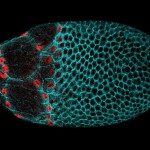Link to Pubmed [PMID] – 15188430
Dev. Dyn. 2004 Jul;230(3):446-60
We have analyzed the expression of the Msx1 gene in the developing mouse brain and examined the brain phenotype in homozygotes. Msx1 is expressed in every cerebral vesicle throughout development, particularly in neuroepithelia, such as those of the fimbria and the medulla. Timing analysis suggests that Msx1(nLacZ) cells delaminate and migrate radially from these epithelia, mainly at embryonic days 14-16, while immunohistochemistry studies reveal that some of the beta-galactosidase migrating cells are oligodendrocytes or astrocytes. Our results suggest that the Msx1 neuroepithelia of fimbria and medulla may be a source of glial precursors. The Msx1 mutants display severe hydrocephalus at birth, while the subcommissural organ, the habenula, and the posterior commissure fail to develop correctly. No label was detected in the mutant subcommissural organ using a specific antibody against Reissner’s fiber. Besides, the fasciculus retroflexus deviates close to the subcommissural organ, while the paraventricular thalamic nucleus shows histological disorganization. Our results implicate the Msx1 gene in the differentiation of the subcommissural organ cells and posterior commissure and that Msx1 protein may play a role in the pathfinding and bundling of the fasciculus retroflexus and in the structural arrangement of the paraventricular thalamic nucleus.
